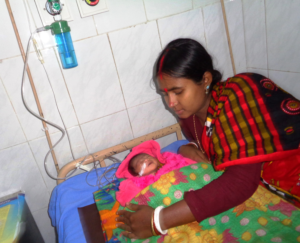By Liza Talukder, Communications Technical Advisor and Dr. Seikh Asiruddin, Senior Technical Advisor for SIAPS Bangladesh. This post originally appeared on MSH’s website.

Tama, a resident of Parokhali village in the Khulna district of Bangladesh, was devastated when her 15-day-old daughter was diagnosed with pneumonia-related complications and needed treatment, including immediate oxygen support. Following instructions from the local doctor, she and her husband rushed their newborn to Khulna Shishu Hospital, situated eight kilometers from her village. Thanks to the oxygen supply system that had been recently installed at the hospital, baby Sangita received a steady flow of medical oxygen and recovered.
“I am happy that we decided to bring my daughter to Khulna Shishu Hospital and start treatment”, said Tama. “If the oxygen support had not been given to her in time, it could have become fatal.”
Tama is one of many mothers who expressed gratitude for how the uninterrupted oxygen supply they received at Khulna Shisu Hospital saved their children’s lives. On average, 25 to 30 children receive oxygen support at the hospital each day.
Khulna Shisu Hospital treats children in the southern part of Bangladesh. This 285-bed secondary-level private hospital for newborns and children was established in 1980 by the local elites of Khulna. Its philanthropic objectives are to provide specialized services, such as a newborn intensive care unit, incubators, surgery, and urology, along with pathological lab and diagnostic services, child nutrition, and a routine expanded program of immunization services. The hospital mainly runs on the revenue it generates, and the government provides a nominal subsidy to adjust its yearly expenses. Need-based donations of medical equipment from local elites and others are assets for the hospital.
At the request of the local USAID mission, the Systems for Improved Access to Pharmaceuticals and Services (SIAPS) Program — funded by USAID and implemented by Management Sciences for Health — and the Social Marketing Company (another USAID-funded project) conducted an assessment to identify ways to increase the capacity and sustainability of the hospital’s systems. The assessment showed that a major challenge was its irregular and manual oxygen supply, which poses a potential risk to many newborns and children.
To address this challenge, SIAPS commissioned a central oxygen supply mechanism within the hospital in February 2016 to strengthen their newborn and child health services. With SIAPS’ technical assistance, the hospital introduced a web-based health information management system to support evidence-based decision-making and strengthen its medicine warehousing system. SIAPS also helped to develop a long-term sustainable plan and marketing strategy to expand the hospital’s services to save more lives.
This collaboration paved the way for SIAPS to build a successful public-private partnership that could speed up progress toward ending preventable child and maternal deaths.

